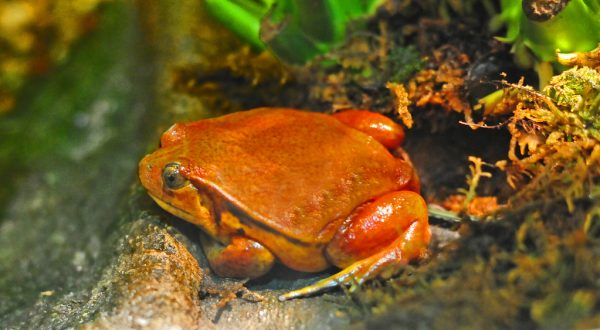Overview Description:
The Tomato Frog (Dyscophus antongilii) is a species of frog in the family Microhylidae, native to Madagascar. As its name suggests, it is bright red or orange-red, similar to a ripe tomato. This distinctive color acts as a warning to potential predators of their toxic skin secretions.
Tomato Frogs are nocturnal and predominantly terrestrial, spending the day hidden in leaf litter or burrowed in soft soils. They become active after dark to feed and mate. These amphibians are known for their unusual defensive strategy; they puff up their bodies to appear larger and more intimidating when threatened.
Taxonomy and Naming:
- Kingdom: Animalia
- Phylum: Chordata
- Class: Amphibia
- Order: Anura
- Family: Microhylidae
- Genus: Dyscophus
- Species: Dyscophus antongilii
Scientific Name:
Dyscophus antongilii
Alternate Names:
Madagascar Tomato Frog
Related Animals:
Antsouhy Tomato Frog, False Tomato Frog, Sambava Tomato Frog
Physical Appearance:
Tomato Frogs are robust and rounded with a distinct, short snout. Females, usually vibrant red or orange, are more significant than males, which are more of a duller orange or yellowish color. They have a white or cream-colored underside, large eyes, and a horizontal, slit-shaped pupil.
The skin of the Tomato Frog is smooth and covered in a slimy secretion. When threatened, they can secrete a sticky white substance that can deter predators and, in some cases, cause allergic reactions in humans.
Weight:
Approximately 7 ounces (200 grams)
Length:
Males: 2.5 inches (6.35 cm), Females: 4 inches (10.16 cm)
Lifespan in the Wild:
6-8 years
Lifespan in Captivity:
Up to 10 years
Diet & Feeding:
The Tomato Frog is an opportunistic feeder with a diet primarily composed of small invertebrates. They consume various insects, including worms, termites, and small invertebrates. They are ambush predators, preferring to wait for their prey to pass by before quickly striking with their sticky, extendable tongues.
In captivity, Tomato Frogs can eat a diet of crickets, mealworms, and other small invertebrates. Juvenile frogs should be fed daily, while adult frogs can be fed every other day.
Native Habitat:
Tomato Frogs are native to the northeastern part of Madagascar, particularly around Antongil Bay. They inhabit the island’s tropical rainforests and are often found in and around the water bodies within these forests. Their habitats include swamps, marshes, and small pools of water, particularly during the breeding season.
They have also adapted well to urban areas and can be found in city drainage ditches and near populated areas.
Current Distribution in the Wild:
Today, the Tomato Frog is predominantly found in northeastern Madagascar, particularly around Antongil Bay. Their population is scattered and local, restricted to specific areas within their range.
Geographical Distribution and Habitat:
Geographically, the Tomato Frog is endemic to Madagascar, with its presence concentrated in the northeastern regions of the island. They are found in tropical rainforests, wetlands, and urban areas where they can easily access small bodies of water.
Biomes:
Tropical Rainforest
Climate Zones:
Tropical
Social Structure:
Tomato Frogs are generally solitary animals, only coming together during the breeding season. Males will call from small pools of water to attract females. Once a female has chosen a male, the pair will stay together until the female has laid her eggs.
Group Name:
Army
Grouping Behavior:
Solitary
Mating Habits:
Tomato Frogs breed during the rainy season. Males attract females with a distinctive call. Once a female has chosen a mate, the male grasps her from behind in an embrace called amplexus. The female then lays her eggs, and the male fertilizes them externally.
Age of Sexual Maturity:
Approximately 1 year
Name of Males, Females, and Offspring:
Males – Male, Females – Female, Offspring – Tadpole
Reproduction Season:
Rainy season
Gestation Period:
No gestation period, as the female lays eggs
Type of Birth:
Oviparous
Age of Weaning:
No weaning period; tadpoles begin to eat small invertebrates after absorbing their yolk sac
Conservation Status:
Near Threatened (IUCN Redlist)
Current Population Wild:
Unknown exact number; populations appear to be in decline
Current Population Captivity:
Common in captivity
Population Description:
The exact population numbers of Tomato Frogs in the wild are unknown, but the species is considered typical within its range. However, populations are believed to be decreasing due to habitat loss and collection for the pet trade.
Population Threats:
The primary threats to Tomato Frogs are habitat loss due to deforestation and collection for the international pet trade. Pollution and disease also pose risks to wild populations.
Conservation Efforts:
Tomato Frogs are protected under national legislation in Madagascar, and collection for the pet trade is regulated. Conservation efforts are focused on preserving their habitat and monitoring wild populations to prevent over-collection.
Fun Facts:
- When a Tomato Frog is threatened, it puffs up its body to appear larger and more intimidating.
- The female Tomato Frog is much larger and more brightly colored than the male.
- Tomato Frogs secrete a sticky substance when threatened, which can cause an allergic reaction in predators and humans.
- Tomato Frogs burrow into the ground during the dry season to keep their skin moist.
- Female Tomato Frogs can lay up to 1,000 to 1,500 eggs.
- Tomato Frogs have a lifespan of 6 to 8 years in the wild but can live up to 10 years in captivity.
- Despite being a terrestrial species, Tomato Frogs are excellent swimmers.
- The Tomato Frog gets its name from its bright red color, which warns predators of its toxic skin.
- They have a small size but a big voice. Their call can be heard from quite a distance.
- They are nocturnal and are most active at night.
AZA Zoos with this Animal:
San Diego Zoo, Bronx Zoo, Smithsonian’s National Zoo, Denver Zoo

